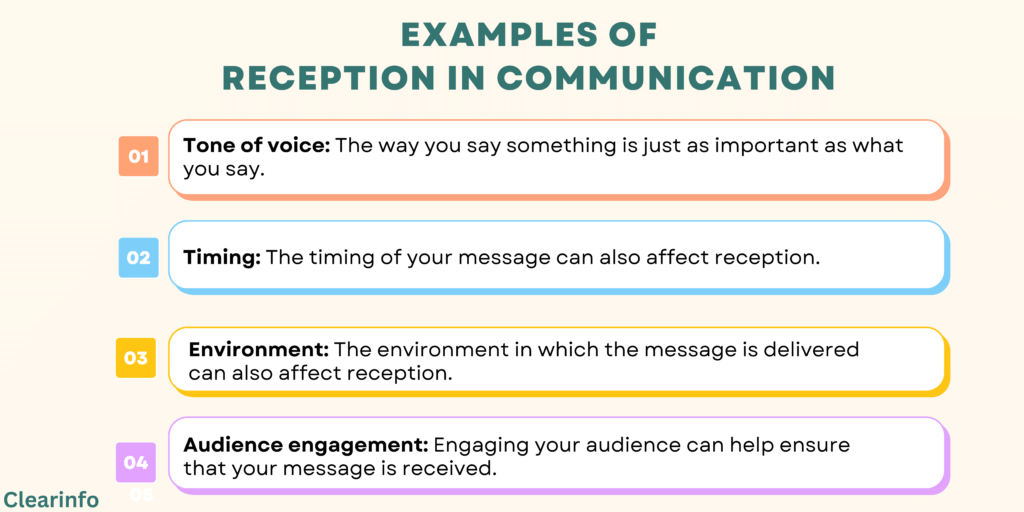Communication is an essential aspect of our daily lives, and it involves both sending and receiving information. While most people focus on how they deliver their message, the act of receiving information is equally important.
To ensure that communication is successful, there needs to be a set of guidelines or principles that govern the reception of information. This is where the Code of Reception in Communication comes into play.
In this blog, we will get into what the Code of Reception in Communication is, its importance, and how it can be used to improve your communication skills with examples.
What is a code of reception in communication?
The code of reception is the framework that we use to interpret and understand the messages we receive from a sender. It is influenced by various factors such as our cultural background, education level, personal experiences, and beliefs.
When we receive a message, we apply this framework to make sense of it and create meaning. Understanding the code of reception is essential to effective communication because it helps us anticipate how our messages will be received and adjust them to ensure that they are correctly understood.
Editors note:
Reception theory originated from the work of Hans-Robert Jauss, a German literary scholar. He introduced the concept in the 1960s and 1970s as part of his efforts to understand the role of the reader or audience in the interpretation of literary texts.
Jauss emphasized the importance of considering the reader’s perspective, experiences, and cultural context in the interpretation of literature, challenging the traditional focus on the author and the text itself.
Reception theory has since evolved and been further developed by various scholars in the fields of literature, cultural studies, and communication. For instance, Stuart Hall’s Encoding/Decoding model is one of his notable contributions to reception theory.
Components of code of reception
The code of reception consists of five components that work together to create an overall impression of the message and influence the receiver’s interpretation.
1/ Clarity and Simplicity:
The first component of effective reception is clarity and simplicity. Your message should be simple and easy to understand. You should avoid including specialized jargon or complex terminology that might confuse your audience.
Using concise, straightforward language will help ensure you communicate your message to your audience. Your wording should be concise, which usually means shorter sentences and paragraphs and avoiding long words and phrases wherever possible.
2/ Appropriateness:
The second component of the Code of Reception is appropriateness. You should always tailor your message to your intended audience. Doing so means you must adjust your tone and style depending on the situation and on who is receiving your message.
It’s crucial to know your audience and adjust your messaging to meet their needs. This includes factors such as their cultural background, age group, education level, and their familiarity with the topic.
3/ Credibility:
The third component of the Code of Reception is credibility. Your message should be trustworthy and backed up by relevant evidence to support any claims you make. Your audience will be more likely to trust and understand your message if you provide them with credible information.
4/ Style and Tone:
The fourth component of the Code of Reception is style and tone. How you deliver your message holds equal importance to the communication itself. Whether you are writing an email or creating content for social media, it’s essential to avoid using a confrontational tone or language that might distance your audience.
Instead, you should choose a friendly and respectful tone that builds rapport and encourages engagement. You should also be aware of your audience’s sensibilities and avoid using humor or sarcasm unless it’s appropriate.
5/ Engagement:
The fifth and final component of the Code of Reception is engagement. Communication is a two-way process, and it’s crucial to encourage your audience to participate in the conversation actively.
You can achieve this by asking questions or encouraging feedback or comments on your written or verbal messages. Engagement creates a more dynamic interaction between you and your audience that creates a stronger sense of community.
Importance of the code of reception in communication
In communication, the code of reception is crucial for successful and meaningful interaction. Here are some key aspects highlighting the importance of an effective code of reception:
1/ Clarity of Message:
One of the primary reasons why the code of reception in communication is essential is clarity. The way you convey your message must be clear, concise, and precise.
People must understand what you are saying or writing. A lack of clarity in your message may result in misunderstandings, confusion, and a communication breakdown. When you communicate, consider your audience’s background, language skills, and level of knowledge of your message’s subject to avoid confusion.
2/ Non-Verbal Communication:
The code of reception is not limited to verbal communication; non-verbal communication also plays a vital role. How you say things, facial expressions, tone of voice, and body language can all influence how your message is interpreted.
For example, the way you deliver an apology can change how it is received, whereas a strict facial expression can convey a message’s seriousness.
3/ The Power of Active Listening:
Active listening is a valuable communication skill that involves not just hearing, but actively engaging with and understanding the message being communicated. It’s an essential part of the code of reception and allows the receiver to ask questions, clarify misunderstandings, and respond appropriately.
Being a good listener demonstrates that you value the message and the person delivering it, which helps create a more positive environment for communication.
4/ Cultural Awareness:
In today’s globalized world, understanding cultural differences is essential in communication. Every culture has its communication styles, language, customs, and non-verbal cues that can impact how messages are received.
Understanding and respecting the differences in communication styles and customs of different cultures can help you adjust your communication to be more effective and avoid misunderstandings.
5/ Importance in Business:
Effective communication is essential in business to build trust, maintain good relationships, and achieve business objectives. When communication breaks down, it leads to a set of problems such as delays, errors, and conflicts.
Insufficient communication, workplace misunderstandings, and poor communication can harm the business’s reputation and result in the loss of clients or customers. The code of reception in communication is vital to ensure that business objectives are met and unnecessary confusion and misunderstandings are avoided.
Reception in communication examples
Reception is a crucial aspect of communication because it can significantly affect the outcome of the communication process. For example, if the receiver misunderstands the message, it can lead to confusion or conflict, which can be harmful to the relationship.
One of the prime examples of reception in communication is Non-Verbal Communication. Nonverbal communication refers to the use of body language and tone of voice to convey information. Ineffective use of nonverbal cues can lead to misinterpretation of the message, and the desired response is not achieved.
For instance, if a person is giving an important presentation, and they are dressed in casual attire, it can signal a lack of professionalism, and this might influence how the audience perceives the speaker’s message.
Another aspect of reception in communication is the audience’s cultural background. Culture can have a significant impact on how people perceive and interpret messages. For example, certain cultures appreciate direct communication, whereas others lean towards an indirect approach. Therefore, it is essential to be aware of the cultural differences of the audience to ensure that the message is understood and positively received.
There are countless other examples of reception in communication:

How to use code of communication to improve communication skills
Here is how you can use codes of communication to significantly improve your communication skills:
1/ Understand Your Audience:
A code of communication includes a set of signals, gestures, and expressions that facilitate communication between people. The first step in using a code of communication is to understand your audience’s language, cultural background, and preferences.
When you know your intended audience, you can tailor the content of your message to fit their needs and expectations. By doing so, you can avoid misunderstandings, and your message can be better received. Also, you can use non-verbal cues, such as gestures, posture, and eye contact to complement your message.
2/ Choose the Right Words:
The choice of words is critical in communication. Choosing the wrong words can lead to confusion, misinterpretation, or even offense. Therefore, using the right words to convey your message is essential. The use of jargon and technical terms may be appropriate in some professions but may not be suitable for communicating with a wider audience.
On the other hand, using simple language, clear and concise sentences, and an active voice can make your message more accessible and understandable.
Furthermore, using rhetorical devices, such as metaphors, analogies, and storytelling can help to capture the audience’s attention and make your message more memorable.
3/ Use Visual Aids:
Visual aids, such as graphs, charts, images, or videos can enhance your communication and make your message more persuasive. They can help you to illustrate complex ideas, provide context, and showcase data or statistics.
However, visual aids must be used appropriately. Too many visuals can be overwhelming, and too little can be ineffective. In addition, visual aids must be accurate, relevant, and accessible to the intended audience.
4/ Practice Active Listening:
Communication is not just about transmitting your message but also about receiving and understanding the message of your audience. Active listening means that you listen with an open mind without interrupting, acknowledging the speaker, and resolving any potential misunderstandings.
Active listening can help you to understand the context, the underlying emotions, and the needs of your audience. It can also help you to tailor your message to fit their expectations and create a positive and productive communication environment.
5/ Understand the elements of communication:
The last step to improve your communication skills by using a code of communication is to have a solid understanding of the elements of communication.
Communication consists of four fundamental components: the sender, who transmits the message; the message, which is the information being conveyed; the receiver, who accepts the message, and the feedback, which is the response provided by the receiver. Understanding these elements and how they work together is essential to effective communication.
It is important to note that improving your communication skills is a process that takes time and practice. By using the code of communication, you can enhance your communication and build better relationships.
Frequently Asked Questions
Q1) What is a reception in communication?
Ans: A reception in communication refers to the process of receiving and interpreting information that has been sent or shared by another person. Fundamentally, it’s about understanding and deriving meaning from what others aim to convey to us.
Q2) What are the codes of communication?
Ans: Codes in communication refer to the various systems of symbols, words, gestures, and other forms of communication used to convey meaning between individuals. These codes can be verbal or nonverbal and are essential for effective communication as they allow us to express our thoughts, feelings, and ideas.
Q3) Why are codes important in communication?
Ans: Codes are crucial in communication because they provide structure and organization to our interactions with others. They help us convey our thoughts and ideas accurately and efficiently, as well as understand the messages being communicated to us. Without codes, communication would be confusing, and less effective. So, it is essential to have a common set of codes that both parties can understand for effective communication.



